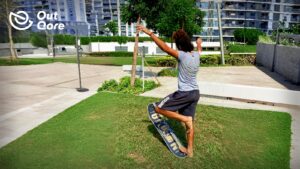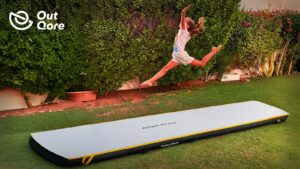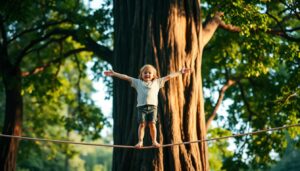Can a simple strip of webbing hung between two trees change how a child learns balance and confidence? We ask this because the answer shapes how families and clinicians in the UAE plan outdoor play and guided sessions.
We introduce how a slackline, a 1–2 inch flat webbing tensioned with a ratchet, becomes a playful activity and a therapeutic tool. It creates a dynamic line to walk, sit, bounce, and turn while the child works on balance and core strength.
Short, frequent sessions help build coordination, posture, stability muscles, and focus without fatigue. Beginner kits usually include a ratchet system, tree protectors, an overhead training line with an arm strap, clear instructions, and a carry bag. Many kits set up in minutes and suit shaded parks or backyards across UAE climates.
Our guide shows practical steps, safety-first setups, and gentle progressions so parents and therapists can choose the best way to introduce this approach. We keep sessions low to the ground, supervised, and adaptable to each child’s needs.
Key Takeaways
- We present a simple tool—webbing and anchors—that blends play and targeted skill building.
- Top benefits: improved balance, coordination, core strength, focus, and confidence.
- Beginner kits make setup quick and safe in UAE parks and shaded yards.
- Short, regular sessions work best to build skills without tiring the child.
- Our framework emphasizes low setups, tree protection, and supervised progressions.
Why Slacklining Works: The Science-Backed Benefits for Children
A tensioned strip of webbing teaches steady feet and steady minds by forcing small, constant adjustments.
Balance, coordination, and stability muscles
Balance improves because the body must make tiny, rapid corrections on a moving surface. Ankles, knees, hips, and trunk engage together to keep a child upright.
These micro‑adjustments boost overall coordination and train the deep stabilizers that support everyday movement.
Core strength, posture, and total-body conditioning
Engaging the core against gentle sway builds posture and low‑impact strength. Practice feels like play but works many muscle groups at once.
This way of training reduces repetitive drills and keeps sessions fun and functional.
Focus, perseverance, and confidence building
Children learn persistence by trying small goals — stand, step, turn. Each success raises confidence and improves focus on a single visual point, which often transfers to classroom tasks.
Fun, play, and screen-free time in the UAE
Outdoor sessions boost mood and energy, especially in early morning or late afternoon in the UAE. Most beginner setups are portable and quick to install in parks or yards.
- Micro‑movements train proprioception and coordinated foot placement.
- Core engagement enhances posture without high impact.
- Playful challenges encourage longer participation and social support.
To translate these benefits into weekly plans and age‑appropriate milestones, visit outqore.com.
Slackline for Kids Therapy: Our How-To Framework
This section maps practical session plans that match age, attention span, and local UAE settings. We give clear goals by age, a compact session arc, and simple setup and safety reminders that fit shaded parks and small yards.
Therapy goals by age and skill level
Age 3–5: stand 10 seconds, steady single-leg hold, assisted steps.
Age 6–8: five controlled steps, calm breathing, basic turns with a helper.
Age 9+: longer walks, 180° turn, short pauses on the line to train balance and coordination.
Session structure: warm-up, line time, cool-down
We use a compact arc: a 5-minute warm-up (joint mobility, marching), 10–15 minutes of focused line practice with an overhead training line if needed, then a 3–5 minute cool-down and reflection.
- Beginners benefit from very short, frequent bouts and a helper at the side.
- Include mini challenges to keep the activity engaging and measurable.
- Record quick outcomes and reflection answers: What felt easier today? What will we try next?
| Target | Session Time | Progression Tip |
|---|---|---|
| Stand 10s | 5–10 min | Add single-leg holds |
| Five steps | 10–15 min | Increase step count weekly |
| 180° turn | 10–15 min | Practice safe dismounts |
We link to outqore.com for printable planners and age templates that match UAE parks and setup checklists. Short rests and routine safety checks around trees keep sessions low-risk and rewarding.
Choosing the Right Slackline Kit: Features, Lengths, and Safety
A sensible kit choice reduces setup time and improves consistency during practice. We focus on clear features that help families and therapists pick gear suited to UAE parks and shaded yards.
Webbing width and feel
Webbing usually comes in 1–2 inches. A 2‑inch line feels steadier for beginners and helps accurate foot placement.
Limited‑stretch webbing aids walking stability. Stretchier webbing adds bounce for later play.
Length and anchors
Common beginner lengths list 50–60 ft, but remember wraps around both trees and ratchet feed add to needed length.
Shorter spans work best for new users and compact yards. Match the kit to your anchor spacing before buying.
Ratchet systems, overhead lines, and protection
A quality ratchet and a clear release mechanism improve safety and longevity in humid, sandy conditions. Single or double‑geared ratchets may be used; check load ratings.
Kits often include an overhead training line, arm strap, wide tree protectors, and a ratchet cover.
“We choose kits that make setup fast and reduce barriers to regular practice.”
What a beginner kit comes with
Most kits come with everything you need get started: webbing, anchors, ratchet, tree protectors, instruction booklet, and a carry bag.
| Feature | Why it matters | Typical spec | Tip |
|---|---|---|---|
| Webbing width | Balance vs. precision | 1–2 inches | Pick 2″ for beginners |
| Length | Matches trees and space | 50–60 ft kits (total) | Measure anchors + wraps |
| Ratchet & protection | Safety and durability | Rated metal ratchet, tree pads | Choose corrosion‑resistant parts |
We recommend visiting outqore.com for curated kits suited to UAE conditions and simple maintenance tips.
Setting Up Safely in the UAE: Anchors, Height, and Tension
Start by choosing healthy trees or sturdy posts and always use wide tree protectors to protect bark and gear. We clear the ground of rocks, thorny debris, and furniture before any session.
Finding suitable trees or posts and using tree protection
Pick two mature, living trees or fixed posts with solid spacing and no visible damage. Use wide protectors to spread load and prevent bark abrasion in sandy, sun-exposed UAE parks.
Line height for low-to-ground kids setups
Keep the line low so it sags slightly under weight but never touches the ground. This minimizes fall height while allowing the child to step on and off safely.
Dialing tension for less wobble and controlled bounce
Tighten the ratchet for reduced wobble; beginners need stability to build balance quickly. Gradually ease tension to add small bounce as skill and confidence grow.
- Anchor choice: healthy trees or fixed posts with wide protectors.
- Pre-session sweep: remove sharp rocks and obstacles from the landing zone.
- Stabilizing tips: an adult can sit on one end or use a training line for first steps.
- Timing and comfort: set up in shade—mornings or late afternoons—and include hydration breaks.
- Teardown: pack gear after use to limit sun and sand damage to webbing and the ratchet.
| Item | Recommendation | Why it matters |
|---|---|---|
| Trees / posts | Mature, healthy, 2+ ft trunk or fixed post | Stable anchors reduce movement and protect bark |
| Line height | Low — 10–20 cm above standing ankle, sags slightly | Minimizes fall distance while allowing stepping on |
| Ratchet tension | Tight for beginners; loosen gradually for bounce | Controls wobble and matches skill progression |
| Ground prep | Clear 2–3 m zone both sides; remove hazards | Reduces injury risk during dismounts and falls |
We maintain a quick system check: inspect anchors, test the ratchet release, and confirm the line clears the ground. For a UAE-focused setup checklist and park etiquette, visit outqore.com.
Step-by-Step: Teaching Kids to Slackline (Beginners to Confident Walkers)
We start with tiny, clear goals that stack into steady progress. Begin with low setup in shaded areas so each child feels safe and can step on and off with ease.
Start with standing and one-leg balance
Begin on stable footing. Hold short stands, then try single-leg holds to train ankle and trunk control. Adults may steady the line by sitting on one end or use an overhead training strap to reduce wobble.
Eyes up, arms high, and precise foot placement
Teach a fixed gaze toward an anchor tree and tall posture. Cue arms high and small, exact steps: heel then big toe along the webbing. Barefoot practice can improve tactile feedback and foot placement.
Progressions: walking, turns, sitting, bouncing
Move to two- and five-step targets, then short turns and seated holds. Add gentle bounce only after stability and core cues are reliable. Keep sessions short, celebrate micro-wins, and use printable cards and videos at outqore.com to track progress.
“Small, measured steps build balance, coordination, and confidence one session at a time.”
Safety First: Practical Guidelines for Parents and Therapists
Our safety checklist turns setup and maintenance into quick, repeatable habits that protect gear and children. We keep the line low and the area clear so each session stays safe and productive.
Surface prep, supervision, and protective gear
Clear a 2–3 meter landing zone on both sides of the line. Remove rocks, branches, and garden furniture.
We recommend close, continuous supervision and optional helmets or pads during early sessions. This reduces risk and supports steady progress.
Setting limits: height, time, and fatigue
Keep height low so the webbing does not touch the ground under weight. Short sessions preserve focus and protect confidence.
Set a clear time limit and stop if attention drops. Most slips happen when children are tired.
Maintenance tips: sun, sand, and ratchet care
Wipe sand from webbing, dry metal parts, and inspect near the ratchet for cuts. Pack gear after each use to limit sun and salt damage.
“Routine checks — anchors, ratchet lock, line height — make every session reliable.”
- Tree protection preserves bark and anchor integrity.
- Quick teardown prevents UV and sand wear.
- Watch for overexertion and adjust tasks to keep core work effective.
| Check | Action | Why it matters |
|---|---|---|
| Ground | Clear a 2–3 m zone | Safe landings reduce injuries |
| Anchors & tree pads | Inspect and protect bark | Stable anchors lower movement |
| Ratchet & webbing | Wipe, dry, inspect edges | Prevents rust and fraying |
| Session limits | Short, supervised bouts | Maintains focus and confidence |
We maintain a full checklist and maintenance guide at outqore.com tailored to UAE heat, sand, and storage best practices.
Making It Fun: Games, Challenges, and Team Play
We turn balance practice into playful challenges that spark quick wins and steady progress. Our goal is to keep sessions short, varied, and social so children stay engaged while learning precise movement and posture.
Obstacle ideas and timed challenges
Obstacle elements—low rope hurdles, narrow boards set across the webbing, and loop threading—add variety and build coordination. Timed tasks like “fastest clean crossing” or “longest one‑leg hold” make repetition into a motivating challenge.
Using a training line and helper strategies
Use a training overhead line and an adult helper to shape arms-up posture and steady eyes. Fade support in small steps so independence grows without losing safety.
“Playful drills and short contests keep attention high and reward steady progress.”
- Bounce control drills and sit‑to‑stand reps build stability without taking the play out of practice.
- Partner games—relays, balance duels, and synchronized moves—teach teamwork and communication.
- Short rotating stations let groups cycle through active time, rest, and feedback efficiently.
| Game | Goal | Time |
|---|---|---|
| One‑leg challenge | Balance & ankle control | 30–60s sets |
| Timed crossing | Precision under speed | Individual attempts, best time counts |
| Team relay | Coordination & social skills | 3–5 short rounds |
| Bounce control | Core stability | 10–15 reps |
We provide printable game cards and group prompts at outqore.com so families and therapists in the UAE can plug engaging activities into any session quickly and keep progress measurable.
Conclusion
,
In conclusion, this approach turns short, playful sessions into real gains in posture, focus, and strength. We show how a slackline practice builds balance, stability, and core strength while keeping play central.
Beginner-friendly kits often come with everything you need: webbing, a ratchet, tree protectors, and a training line. Choose the right length and a quality ratchet so the setup matches your space in the UAE.
Keep sessions short and frequent to grow confidence and avoid fatigue. Move from simple stands to turns and gentle bounce. Maintain low height, clear the ground, and inspect gear regularly to keep practice safe and fun.
Visit outqore.com to view curated kits, printable plans, and local guides. Contact us if you want a tailored program that brings slacklining kids programs into schools, clinics, or backyards.



